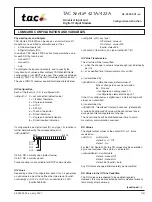
5.52.194VA.01.01.00
5
2.3
Requirements for the operating personnel
The units may only be operated by qualified persons that are appropriately trained and that are familiar with
it.
They must have their employer’s authorization for operation of the units.
Before starting work, the operating personnel must have read the operating and installation instructions,
especially the chapter "Safety Instructions".
This is especially important for operating personnel that rarely uses the equipment, i.e. for installation or
maintenance work.
DANGER!
In order to avoid severe injury, please pay attention to the following when using the equipment:
Use protective clothes/equipment.
Do not wear long hair hanging down open.
Do not wear rings or other jewelry.
Do not wear clothes that are too big/wide.
Do not reach into ropes, chains, drive parts or other moving parts with your hands
2.4
Appropriate use
The appropriate use of the hoists is vertical lifting and lowering of unguided loads up to the maximum rated
load. In combination with trolleys, loads can also be moved horizontally.
The permitted safe working load of the devices must not be exceeded! An exception can be made during the
load test before initial operation, carried out by a licensed qualified person.
Defective devices and load suspension devices must not be used until they have been repaired! Only
original spare parts must be used. Non-compliance will result in any warranty claims becoming void.
Liability and warranty will become void if unauthorized modifications of the units are made by the user!
The permissible ambient temperature when operating the devices:
Type of drive
Device classification for
not explosive atmosphere
Explosive atmosphere
according to
ATEX
)* )**
Manually driven
-20°C/+50°C
-20°C/+40°C
Motor driven
-20°C/+40°C
-20°C/+40°C
) * At an atmospheric pressure range from 0.8bar to 1.1bar and an oxygen content of approx. 21%
) ** Devices of this category have been specially modified and labeled by the manufacturer
DANGER!
The ambient temperature range must not be exceeded!
DANGER!
It’s only allowed to use the unit in the EX-classification which is named on the type plate; or in lower
classes.
NOTICE!
If the units are not used as intended, safe operation is not guaranteed.
The operator alone is responsible for all personal injury and damage to property resulting from improper
use.
DANGER!
It’s only allowed to use the unit in the EX-classification which is named on the type plate; or in lower
classes.






































